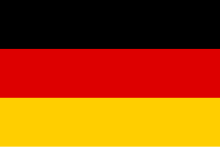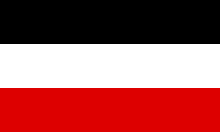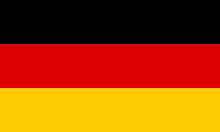Anti-Flag Desecration Law (Germany)
The Nazi Anti-Flag Desecration Law was not a Nazi law, but an amendment to the Second Reich Strafgesetzbuch signed into law as a Notverordnung in the Weimarer Republik on 19 December 1932[1] by Reichspräsident Paul von Hindenburg and the cabinet of Reichskanzler Kurt von Schleicher, making it illegal to desecrate the flag by "insulting or maliciously and with intent belittling" the Reich, the Länder, their constitution, colors, or flags, or the Wehrmacht.


 Flag of Weimar Germany (1919–33)
Flag of Weimar Germany (1919–33)Initially, §134a StGB protected only the flag of the democratic Germany.
Later legislation, on 12 March 1933, and the Reichsflaggengesetz of 15 September 1935, extended the protection to the Hakenkreuzfahne.
Paragraph introduced by Reichspräsident von Hindenburg on 19 December 1932
§ 134a. Wer öffentlich das Reich oder eines der Länder, ihre Verfassung, ihre Farben oder Flaggen oder die deutsche Wehrmacht beschimpft oder böswillig und mit Überlegung verächtlich macht, wird mit Gefängnis bestraft.
Case studies of §134a application
21 December 1934: Defendant acquitted of desecrating SS flag
On 21 December 1934, a defendant accused of desecrating the SS flag was acquitted, because the insignia of a sub-organisation of the NSDAP were not considered protected under §134a StGB.[3]
26 July 1935: New York demonstrators acquitted of tearing down NSDAP flag
On 26 July 1935 in New York a group of demonstrators boarded the SS Bremen, tore the Nazi party flag from the jackstaff and threw it into the Hudson River. The German ambassador sharply protested, but the protest was rejected, with the judgement that only a party symbol was harmed and the national flag was not affected. On 15 September 1935, in response to this incident, the Reichsflaggengesetz (Reichs flag law) (RGBl. I S. 1145) came into effect, declaring the Nazi flag to be the exclusive national flag of Germany and removing the status of the black-white-red tricolor flag of the German Empire as co-national flag.
Laws specifying which flag is the German national flag
Black-red-white flag reintroduced and Nazi flag introduced on 12 March 1933


 National flag of Germany (1933–35), jointly with the swastika flag.
National flag of Germany (1933–35), jointly with the swastika flag.

 National flag of Germany and marine jack of Germany (1935–45)
National flag of Germany and marine jack of Germany (1935–45)After the Nazi Party seized power on 30 January 1933, the black-red-gold flag was swiftly scrapped; a ruling on 12 March established two legal national flags: the reintroduced black-white-red imperial tricolour and the flag of the Nazi Party.[4][5]
Reichsflaggengesetz, 15 September 1935
The Reichsflaggengesetz[6] that declared the Hakenkreuzfahne as the only national flag was announced at the annual party rally in Nuremberg[7] on 15 September 1935.
Current (as of 1 January 1975) version of the Anti-Flag Desecration Law


 Flag of the Federal Republic of Germany (1949–present)
Flag of the Federal Republic of Germany (1949–present)Flag of the German Democratic Republic (1949–59)
§ 90a. Verunglimpfung des Staates und seiner Symbole.
(1) Wer öffentlich, in einer Versammlung oder durch Verbreiten von Schriften
1. die Bundesrepublik Deutschland oder eines ihrer Länder oder ihre verfassungsmäßige Ordnung
beschimpft oder böswillig verächtlich macht
oder
2. die Farben, die Flagge, das Wappen oder die Hymne der Bundesrepublik Deutschland
oder eines ihrer Länder verunglimpft,
wird mit Freiheitsstrafe bis zu drei Jahren oder mit Geldstrafe bestraft.
(2) [1] Ebenso wird bestraft, wer eine öffentlich gezeigte Flagge der Bundesrepublik Deutschland oder eines ihrer Länder
oder ein von einer Behörde öffentlich angebrachtes Hoheitszeichen der Bundesrepublik Deutschland oder eines ihrer Länder
entfernt, zerstört, beschädigt, unbrauchbar oder unkenntlich macht oder beschimpfenden Unfug daran verübt.
[2] Der Versuch ist strafbar.
(3) Die Strafe ist Freiheitsstrafe bis zu fünf Jahren oder Geldstrafe,
wenn der Täter sich durch die Tat absichtlich für Bestrebungen
gegen den Bestand der Bundesrepublik Deutschland oder gegen Verfassungsgrundsätze einsetzt.
References
- ^ Verordnung des Reichspräsidenten zur Erhaltung des inneren Friedens, 19. Dezember 1932, Deutsches Reichsgesetzblatt Teil I 1867-1945 : Österreichische Nationalbibliothek, ALEX Historische Rechts- und Gesetzestexte Online, retrieved 17 August 2017
- ^ §134a StGB, version between 21 December 1932 and 4 February 1946 : lexetius.com, retrieved 17 August 2017
- ^ Acquittal of a defendant who desecrated the SS flag, 21 December 1934 : Lothar Gruchmann, Justiz im Dritten Reich 1933-1940: Anpassung und Unterwerfung in der Ära Gürtner, p.848, retrieved from Google Books, 17 August 2017
- ^ von Hindenburg, Paul (12 March 1933). "Erlaß des Reichspräsidenten über die vorläufige Regelung der Flaggenhissung" [Decree of the President for the provisional regulation of raising flags]. documentArchiv.de (in German). Retrieved 17 July 2010.
- ^ Fornax. "The German Swastika Flag 1933–1945". Historical flags of our ancestors. Retrieved 17 July 2010.
- ^ Government of the German Reich (15 September 1935). "Reichsflaggengesetz" [Reich Flag Act]. documentArchiv.de (in German). Retrieved 23 December 2007.
- ^ GERMANY: Little Man, Big Doings, TIME Magazine, 23 September 1935
- ^ §90a StGB, (current) version of 1 January 1975 : lexetius.com, retrieved 17 August 2017
